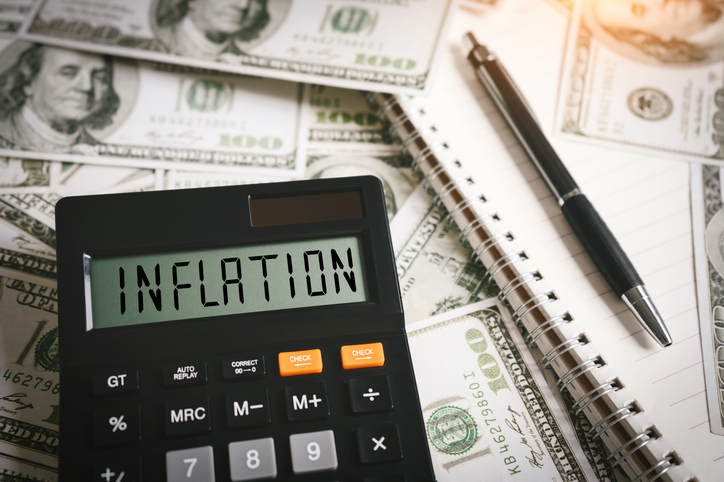Inflation under Trump and Biden reflects two very different economic backdrops. During Trump’s first presidency, inflation remained modest, with rates generally staying below the Federal Reserve’s 2% target. Under Biden, inflation surged beginning in 2021, influenced by supply chain disruptions, stimulus spending and rising energy costs. Forecasts for a second Trump term suggest that his tariff and immigration policies could lead to renewed inflationary pressure rather than a return to pre-2020 trends.
Do Presidents Impact Inflation?
Presidents can influence inflation indirectly through fiscal policy, regulatory priorities and appointments to the Federal Reserve. However, they don’t control inflation outright.
The Federal Reserve plays a major role by setting interest rates and using monetary policy to manage inflation. It does this independently of the White House. However, presidential policies on taxes, spending, tariffs and immigration enforcement can affect demand, labor supply and supply chains. These can in turn influence price levels.
For example, large stimulus packages can boost consumer spending, while tariffs may increase input costs for businesses. Immigration policies that reduce the labor force may contribute to wage pressures, which can ripple through to consumer prices.
Still, inflation remains outside presidential direct control. It is also shaped by global trends, commodity prices and unforeseen shocks like pandemics or wars. While it’s common to credit or blame a president for inflation during their term, it’s often the result of many overlapping factors. These can include decisions made by prior administrations, private sector behavior and international economic dynamics.
Inflation Under Trump
During Donald Trump’s presidency from 2017 to early 2021, inflation remained relatively low and stable. Annual inflation, as measured by the Consumer Price Index (CPI), hovered around 2% or lower for most of his term. In 2020, inflation dropped to just 1.2% due to the economic slowdown brought on by the COVID-19 pandemic. The Federal Reserve continued its low-interest-rate policies during this period, and core inflation stayed subdued even as the economy expanded prior to the pandemic.
Trump’s policies focused heavily on tax cuts, deregulation and tariffs. The 2017 Tax Cuts and Jobs Act stimulated consumer and business spending, but inflation remained contained. At the same time, tariffs on Chinese goods and other imports did raise prices in some sectors. Overall, the effect on headline inflation was modest.
The administration’s immigration restrictions may have constrained labor supply slightly, but those effects were muted relative to broader economic forces. Toward the end of Trump’s term, pandemic-related disruptions began to create upward pressure on prices.
However, inflation did not meaningfully accelerate until after Trump left office. Most major inflationary surges tied to supply chain breakdowns and stimulus spending occurred in 2021 and beyond.
Inflation Under Biden
Inflation rose sharply during Joe Biden’s presidency, especially in the first two years. In 2021, the CPI climbed to 7.0% by December and continued to rise the following year, It peaked at 9.1% in June 2023—the highest levels in four decades.
Multiple factors contributed. They included global supply chain disruptions, strong consumer demand, energy price spikes and fiscal stimulus in response to the pandemic.
The American Rescue Plan, enacted in March 2021, injected $1.9 trillion into the economy through direct payments, unemployment benefits and aid to state and local governments. Critics argue this added fuel to inflationary pressure. However, others point to lingering pandemic effects and Russia’s invasion of Ukraine as larger contributors to global price instability.
The Federal Reserve responded with aggressive interest rate hikes starting in 2022, tightening credit and slowing inflation’s momentum. By mid-2023, inflation had cooled considerably but remained above the Fed’s 2% target.
Biden’s administration emphasized infrastructure investment and clean energy spending. Those policies could affect long-term supply dynamics but had limited immediate impact on inflation trends. Overall, the inflation surge under Biden reflected both domestic policy choices and global economic shocks.
Inflation in Trump’s 2nd Term

Trump’s second-term economic agenda has centered on a broad expansion of import tariffs, including a 10% baseline tariff on all goods entering the U.S. and steeper rates targeting specific countries like China. Economists expect inflation to climb as the full effect of this strategy plays out.
In the first six months of Trump’s second term in office (January through June 2025), inflation edged upward by an average of 2.6%. In April, a universal 10–25% import tariff sparked immediate pressure on consumer prices and contributed to an inflation rate of about 2.7% in June, up from 2.4% in May.
Analysts highlight that rapid and broad tariffs—covering steel, autos, electronics and more—have raised input costs for manufacturers and retailers, who are passing those on to consumers. Deloitte forecasts average CPI growth will hit around 2.9% in 2025 and accelerate to about 3.2% in 2026 if tariffs remain elevated.
Inflation Under Trump vs. Biden
Comparing average annual inflation rates between Trump’s first term and Biden’s presidency highlights how broader economic conditions and policy choices shaped each period.
Trump’s term from 2017 to 2020 saw inflation average about 1.9%, with price growth relatively stable amid low interest rates and modest economic expansion. Biden’s four years, by contrast, produced an average annual inflation rate near 5%, reflecting a sharp post-pandemic surge followed by gradual cooling as the Federal Reserve raised interest rates.
| Year | President | Average Inflation Rate |
|---|---|---|
| 2025 | Trump | 2.6% (through June) |
| 2024 | Biden | 2.9% |
| 2023 | Biden | 4.1% |
| 2022 | Biden | 8% |
| 2021 | Biden | 4.7% |
| 2020 | Trump | 1.2% |
| 2019 | Trump | 1.8% |
| 2018 | Trump | 2.4% |
| 2017 | Trump | 2.1% |
These averages, however, mask meaningful differences in volatility and timing. Inflation under Trump trended within a narrow range until the COVID-19 shock lowered demand. Under Biden, inflation jumped quickly in 2021 and remained elevated through mid-2023 before easing.
What differentiates the two periods isn’t just the raw numbers but how inflation behaved in response to shocks, fiscal policy and supply constraints. This underscores that similar inflation rates can reflect very different underlying dynamics depending on timing, cause and policy response.
Bottom Line
Inflation under Trump and Biden has followed markedly different paths, shaped by contrasting policy responses and external shocks. While headline numbers offer a way to compare outcomes, the broader context, including pandemic disruptions, supply chain instability and changes in trade policy, shows how inflation can emerge, recede or persist under different conditions.
Tips for Beating Inflation
- An advisor can help you reassess your portfolio’s inflation sensitivity, rebalance your asset allocation and explore investment opportunities that align with long-term purchasing power preservation. Finding a financial advisor doesn’t have to be hard. SmartAsset’s free tool matches you with vetted financial advisors who serve your area, and you can have a free introductory call with your advisor matches to decide which one you feel is right for you. If you’re ready to find an advisor who can help you achieve your financial goals, get started now.
- Focus on the inflation-adjusted (real) performance of your investments rather than just nominal gains. A portfolio earning 5% annually in a 4% inflation environment is effectively growing by just 1%.
Photo credit: ©iStock.com/Dilok Klaisataporn, ©iStock.com/Khanchit Khirisutchalual, ©iStock.com/gesrey
Read the full article here
